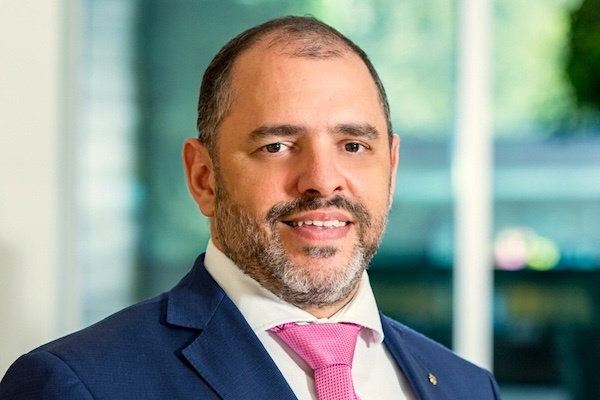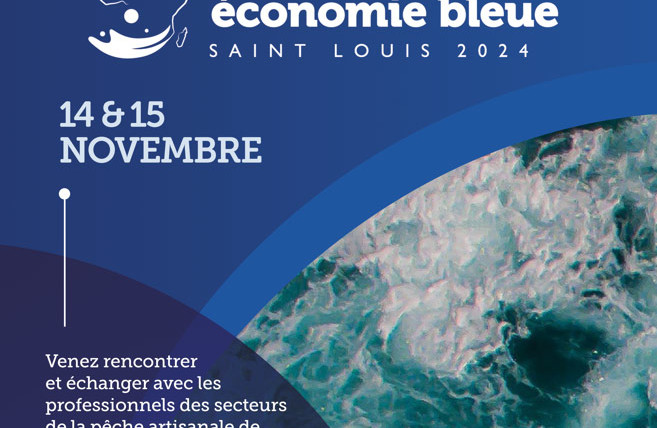On the occasion of the historic call of the MSC Diletta, the largest container ship ever to dock in Lomé, Ecofin Agency spoke with Gregory Krief, Managing Director of MSC Togo. He discussed the strategic choice of the Port of Lomé, the growing strength of its infrastructure, development prospects, and the challenges posed by regional competition and maritime security.
Ecofin Agency: The MSC Diletta, with its capacity of 24,000 TEUs, is the largest container ship ever received on the West African coast. Would you say this is a first for the continent?
Gregory Krief: For Togo, this is a symbolic milestone made possible by the joint efforts of MSC and the Autonomous Port of Lomé. The MSC Diletta is the first 24,000 TEU vessel to enter Lomé. It called at another port before arriving here and will continue on to other ports in the region afterward. But the Lomé call marks our very first official event celebrating the arrival of this class of vessel on the continent. It is, therefore, a symbolic moment.
AE: Why was the Port of Lomé chosen for this symbolic stop? And what does this decision represent for Togo’s place in MSC’s global network, the world leader in maritime transport?
GK: The MSC Diletta was integrated into an existing service, the “Africa Express Service,” which connects Asia to West Africa. This service serves several Chinese ports, Vietnam, transits through Singapore (connected to Southeast Asia), and then arrives at Lomé.
Originally, it was thanks to Lomé’s terminal that this service could be launched: it was the only port at the time capable of handling ships of 300 meters, then 330 meters, then 360 meters. Today, other ports have also modernized and can receive 400-meter vessels, such as Tema in Ghana, Abidjan in Côte d’Ivoire, and Kribi in Cameroon.
The choice to send ships of this capacity responds to a demand from our customers, who want more direct connections with Asia and larger transported volumes. As a partner to our clients, it is our responsibility to support them in this evolution.
Regarding Togo’s position, it is important to note that Lomé is already a strategic regional hub for MSC. It is not just an entry port for Togo: it is also a gateway to many countries in the sub-region, notably the Sahel and coastal countries.
From Lomé, thanks to MSC’s intra-African maritime links, we can serve a large part of the continent weekly, from Dakar to Angola and even South Africa. It is indeed the only port in the sub-region offering such coverage through our MSC network.
“From Lomé, thanks to MSC’s intra-African maritime links, we can serve a large part of the continent weekly.”
AE: With the arrival of giant ships like the MSC Diletta on the “Africa Express” line, what concrete changes do you anticipate in terms of flow management and logistics organization? Is the Port of Lomé ready today to handle this increased traffic?
GK: MSC in Lomé was the first port to host the “Africa Express” service when it was created in 2010. Since then, MSC Togo has always been a pioneer in receiving large vessels: we started with 300-meter ships, then 330, 366, and finally 400 meters.
Last year, we welcomed the MSC Léanne, the first 400-meter vessel to dock exclusively at Lomé. This was made possible thanks to the specific training of Togolese pilots in Sorrento, on a simulator, to validate the port’s maneuverability for these giants of the sea.
Together with Togolese authorities, we have constantly worked to keep Lomé among the most modern and efficient ports. This ongoing effort aims to promote maximum logistical excellence to maintain our competitive edge and make Lomé the HUB of excellence in the region.
Concretely, we are not worried: Lomé Container Terminal (LCT) has a handling capacity of 2.5 to 2.7 million TEU moves, while the current volume processed is around 1.7 million. So, we have a comfortable margin to absorb the expected increase in traffic, notably thanks to continuous modernization efforts (digitalization and dematerialization) and new customs agreements that will facilitate connections with hinterland countries such as Niger and Burkina Faso.
The necessary investments to support this growth are already underway.
“Lomé Container Terminal has a handling capacity of 2.5 to 2.7 million TEU moves, while the current volume processed is around 1.7 million.”
AE: You are also present in Abidjan. Some observers mention a possible reorganization of flows between your different regional platforms, notably between Lomé, Abidjan, and to some extent Tema. How do you see the articulation between these hubs?
GK: The terminals of Abidjan or Tema are mainly focused on handling domestic flows from their domestic and cross-border corridors. Due to its demographic and economic weight, Abidjan alone generates considerable import-export volumes, requiring strong port capacity. Several terminals and many shipping companies are present there to meet this internal demand.
In Togo, the situation is different. The local volume is limited by the population size. However, the Port of Lomé benefits from a major strategic advantage: it is an offshore port, accessible without passing through a lagoon area, with significant draft.
This allows us to develop at Lomé a platform mainly dedicated to regional transshipment, thanks to specific investments made over several years by MSC, while also serving local and hinterland customers.
“The Port of Lomé benefits from a major strategic advantage: it is an offshore port, accessible without passing through a lagoon area, with significant draft.”
To give an idea, the volume of Togolese domestic flows represents about 4-6% of the capacity of Lomé terminal. The bulk of our maritime activity therefore relies on transshipment for the benefit of the entire sub-region.
In summary, Abidjan and Tema are primarily terminals meant to support their very dynamic domestic markets. Lomé, on the other hand, is positioned as a transshipment hub, mainly dedicated to MSC operations.
For example, Ivorian volumes are generally handled directly on certain services in Abidjan, without transshipment via Lomé. But for other markets — notably countries whose ports cannot accommodate 400-meter vessels or as a hub for intra-African flows — Lomé plays a central role.
“For countries whose ports cannot accommodate 400-meter vessels or as a hub for intra-African flows, Lomé plays a central role.”
AE: The group announced a few years ago a $500 million investment plan over ten years for the Port of Lomé. Where do you stand today in the deployment of this plan?
GK: Indeed, MSC Group announced a commitment of $500 million for the development of Lomé terminal over a decade. To date, this initial investment has already been exceeded.
We continue to invest actively to consolidate Lomé’s position as a reference hub in West Africa, in line with the commitment made with Togolese authorities within the framework of the National Development Plan.
Although today, at the vessel level, we have reached the current size limit — the largest being 400 meters — we are already preparing for the future, as new, even larger vessels may appear. So, we invest proactively.
Concretely, we have expanded the terminal with five additional hectares, acquired new equipment, added cranes, gantries, and RTGs (rubber-tired gantry cranes), as well as complementary ground equipment to improve the handling speed of vessels and our local customers and increase container handling capacity.
There is also the possibility of extending toward the southern part of the terminal, provided volume growth continues.
AE: Do you have a figure estimate of investments already made and those underway?
GK: Approximately, we have exceeded 500 million euros invested since the start of our concession in 2008, with effective operation starting in 2014.
Today, including new ongoing investments, we estimate being close to an additional hundred million euros. It should also be noted that MSC invests heavily at sea by putting all these vessels into service, enabling services such as the “Africa Express” to exist and connect Africa to the rest of the world.
“We have exceeded 500 million euros invested since the start of our concession in 2008, with effective operation starting in 2014.”
AE: With tensions between Benin and Niger, some observers mention a re-routing of trade flows toward the Port of Lomé. Have you noticed any concrete impact on your activity?
GK: The re-routing of flows to Lomé is explained by several factors beyond the political context alone. It is important to distinguish between containerized products and bulk products.
Some bulk volumes, especially food products like rice, which were temporarily suspended for container export, affected dynamics.
We lost some containerized rice volumes, but this decrease was offset by new flows destined for Niger via Lomé. Ultimately, even though the context was uncertain, the Port of Lomé managed to stabilize its volumes.
To give an idea: in 2024, despite expectations of decline due to reduced containerized rice transport, we recorded a 2-3% increase in container volumes compared to 2023, which was already an exceptional year.
For example, in March 2024, we reached a historic record with over 123,000 TEU moves (equivalent to about 175,000 TEU) in one month at Lomé terminal. These figures include both unloading and loading operations.
For comparison, the volume of containers destined solely for the Togolese market represents about 20-22,000 TEU per month at the beginning of the year, a small fraction of the total handled, illustrating well the regional hub role of Lomé.
“In March 2024, we reached a historic record with over 123,000 TEU moves (equivalent to about 175,000 TEU) in one month at Lomé terminal.”
AE: Regarding customs infrastructure and trade facilitation, where do the initiatives stand for interconnection with hinterland countries?
GK: Togolese authorities have signed customs interconnection agreements with several hinterland countries, notably Niger and Burkina Faso.
These agreements are now in the implementation phase. The goal is to create interconnected digital systems that will streamline customs formalities and accelerate flows.
This is a strategic development: today, processing speed is a key factor in port competitiveness. With OTR customs, PAL, the single window, and various stakeholders in the process, we do everything possible to improve efficiency and speed container clearance with the support of Togolese authorities.
AE: With Bolloré Africa Logistics’ acquisition, now AGL, MSC has two terminals at the Port of Lomé: LCT and Togo Terminal. How do you coordinate synergies between these two entities? Is there complementarity or competition?
GK: Two aspects must be distinguished. Since MSC acquired AGL, relations between LCT (Lomé Container Terminal) and Togo Terminal, operated by AGL, are clearly defined and structured. Even though these two terminals are now part of the same group, they operate completely independently. AGL remains commercially independent from LCT, ensuring healthy competition and a diversity of services for customers. Each entity makes decisions independently, whether MSC, LCT, MEDLOG (our logistics branch), or AGL.
“Even though LCT and AGL are part of the same group today, they operate completely independently.”
Our approach is simple: MSC focuses on LCT for its volumes, while other carriers focus on AGL terminal. This allows us to remain efficient and meet all clients’ expectations. At the group level, we encourage smart synergies to maximize operational efficiency, always in the client’s interest. This complementarity between the two terminals contributes to logistical excellence and helps maintain Lomé’s port competitiveness and strengthen its regional attractiveness.
AE: There is currently an increase in investments in port infrastructure along the Gulf of Guinea, whether in Cotonou, Tema, Abidjan, or Kribi. Do you think Lomé has the necessary assets to maintain its lead? What are its comparative advantages?
GK: Each port is sized according to its domestic market. Lomé was designed not only to meet national needs but also to become a true regional transshipment hub. The port has direct offshore access, without passing through a lagoon, which gives it a strategic advantage, especially regarding call time and capacity.
In March 2024, we broke a record with 123,000 container moves in one month, corresponding to about 175,000 to 177,000 TEU. In this volume, only 23,000 containers were destined for the Togolese market, showing the importance of transshipment for Lomé. The terminal’s average productivity is 32.5 moves per crane per hour as of March 2025, a very high level surpassing most African and even international terminals.
To maintain this momentum, we launched significant new investments financed by Terminal Investment Limited (TIL), MSC’s subsidiary, and China Merchants, our strategic partners. They include dredging the access channel and acquiring new, higher-capacity gantries (such as the last 5 already acquired) capable of handling the largest vessels of today and tomorrow.
MSC’s strength also lies in its human capital and the close relationship between MSC and LCT teams. For ten years, we have developed recognized local expertise. Today, pilots and operators from other African ports come to Lomé to train in our methods and productivity standards. This confirms that Lomé maintains, thanks to operational performance and continuous investments, a lead over regional competitors.
“We have developed recognized local expertise. Today, pilots and operators from other African ports come to Lomé to train in our methods and productivity standards.”
AE: Are you considering creating a school or academy to support maritime training in Togo?
GK: Our role is not to replace authorities in such a strategic sector. What we try to do is contribute, at our level, to inclusive growth by training our internal




